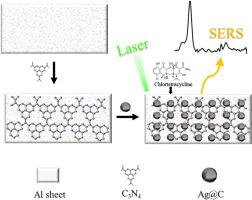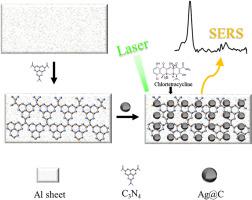Al/C3N4/Ag@C中电磁和化学协同增强对基于拉曼的氯四环素传感
IF 6
2区 化学
Q1 CHEMISTRY, ANALYTICAL
引用次数: 0
摘要
抗生素残留由于其持久性、生物活性和耐药潜力,严重威胁着生态和人类健康。在这些污染物中,常用的兽用抗生素氯四环素在水生系统中有规律地积累,并通过促进微生物耐药性和生态紊乱而造成重大危害。为了有效监测和减轻这种风险,已经开发了各种分析技术,以确定环境基质中的微量污染物。在这些分析技术中,表面增强拉曼散射(SERS)以其检测环境中痕量物质的高灵敏度而脱颖而出。结果成功构建了二维Al/C3N4/Ag@C纳米复合底物,对氯四环素具有良好的SERS检测性能。通过连续分层技术,超薄石墨氮化碳(g-C3N4)和均匀分布的碳包覆银纳米粒子(Ag@C)被沉积在化学蚀刻的铝板上。Al/C3N4/Ag@C复合材料独特地结合了电磁增强和化学增强机制,显著增强了拉曼信号。优于传统和最近报道的底物,该复合材料对标准探针分子罗丹明6G的检测限为6.91×10-12 M,对氯四环素的检测限为1.11×10-14 M。通过电子显微镜、x射线衍射、x射线光电子能谱、时域有限差分模拟等综合表征,验证了复合衬底结构均匀、重复性好、稳定性高等特点。此外,制造过程具有高度可重复性和易于扩展的实际环境监测应用。本工作提出了一种鲁棒性和可扩展的SERS底物Al/C3N4/Ag@C,该底物对环境中抗生素的检测具有非凡的敏感性和稳定性。其化学和电磁增强的新组合不仅克服了与纳米颗粒氧化和信号不稳定性相关的常见挑战,而且还提供了水体中一致的超痕量水平监测。从而大大改进了有用的抗生素监测方法,在环境保护和公众健康保障方面具有广阔的前景。本文章由计算机程序翻译,如有差异,请以英文原文为准。


Synergistic electromagnetic and chemical enhancements in Al/C3N4/Ag@C for Raman-based chlortetracycline sensing
Background
Because of their persistence, bioactivity, and resistance potential, antibiotic residues seriously threaten ecology and human health. Among these pollutants, the frequently used veterinary antibiotic chlortetracycline regularly accumulates in aquatic systems and causes significant hazards by promoting microbial resistance and ecological disturbance. For effective monitoring and mitigation of such risks, a variety of analytical techniques have been developed for identifying trace pollutants within environmental matrices. Surface-enhanced Raman scattering (SERS), among these analytical techniques, stands out for its highly sensitive capability to detect trace substances in the environment.
Results
We successfully constructed a two-dimensional Al/C3N4/Ag@C nanocomposite substrate exhibiting remarkable performance in the SERS detection of chlortetracycline. By means of a successive layering technique, ultrathin graphitic carbon nitride (g-C3N4) and uniformly distributed carbon-coated silver nanoparticles (Ag@C) were deposited onto chemically etched aluminum sheets. The resulting Al/C3N4/Ag@C composite significantly enhanced Raman signals by uniquely combining electromagnetic and chemical enhancement mechanisms. Outperforming conventional and recently reported substrates, this composite achieved a detection limit of 6.91 × 10−12 M for the standard probe molecule Rhodamine 6G and a remarkable 1.11 × 10−14 M were obtained for chlortetracycline. The uniform structure, excellent repeatability, and high stability of the hybrid substrate were validated through comprehensive characterization, including electron microscopy, X-ray diffraction, X-ray photoelectron spectroscopy, and finite-difference time-domain simulation. Furthermore, the fabrication process is highly reproducible and easily scalable for practical environmental monitoring applications.
Significance and novelty
This work presents a robust and scalable SERS substrate, Al/C3N4/Ag@C, which exhibits extraordinary sensitivity and stability for the detection of antibiotics in environment. Its novel combination of chemical and electromagnetic enhancements not only overcomes common challenges related to nanoparticle oxidation and signal instability but also provides consistent ultra-trace level monitoring of chlortetracycline in water bodies. Thus, it substantially improves useful antibiotic monitoring methods and presents great prospects for environmental protection and public health safeguarding.
求助全文
通过发布文献求助,成功后即可免费获取论文全文。
去求助
来源期刊

Analytica Chimica Acta
化学-分析化学
CiteScore
10.40
自引率
6.50%
发文量
1081
审稿时长
38 days
期刊介绍:
Analytica Chimica Acta has an open access mirror journal Analytica Chimica Acta: X, sharing the same aims and scope, editorial team, submission system and rigorous peer review.
Analytica Chimica Acta provides a forum for the rapid publication of original research, and critical, comprehensive reviews dealing with all aspects of fundamental and applied modern analytical chemistry. The journal welcomes the submission of research papers which report studies concerning the development of new and significant analytical methodologies. In determining the suitability of submitted articles for publication, particular scrutiny will be placed on the degree of novelty and impact of the research and the extent to which it adds to the existing body of knowledge in analytical chemistry.
 求助内容:
求助内容: 应助结果提醒方式:
应助结果提醒方式:


